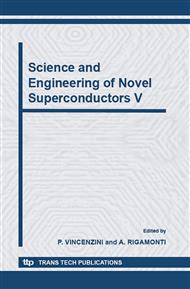p.165
p.170
p.180
p.188
p.195
p.204
p.212
p.220
p.228
Concepts for HTS and MgB2 in Transformers
Abstract:
After the emergence of AC NbTi strands, superconducting transformers were successfully built. But the very high cost of 4 K cryogenics made these transformers economically not attractive. The high Tc superconductors (HTS), operating at much higher temperatures, change these conclusions with low cost HTS conductors. The high cost of PIT tapes and the relatively large AC losses remain issues. The second generation HTS wires, the REBCO coated conductors, are under development and achieved substantial progress recently. They operate at higher temperatures and intrinsically show lower AC losses especially for transformers. MgB2 is the third option. The magnetic flux density conditions make possible the operation at 27 K and they show low costs. This paper provides a preliminary design for an on-board 40 MVA transformer using YBCO coated conductors and MgB2 wires. Both superconducting transformers show similar volume and weight. The power density per unit mass and volume is improved by a factor about two, cryogenic included, compared to resistive systems. This makes them very attractive for on-board mobile systems. The economical point of view will be discussed based on some targets price/performance for superconductors and cryocoolers. MgB2 is penalized by its operation at lower temperature (27 K / 77 K), which makes cryogenics very expensive. The advantage of the low cost of MgB2 compared to REBCO may be lost except with very low AC loss MgB2 tapes.
Info:
Periodical:
Pages:
195-203
Citation:
Online since:
October 2006
Authors:
Keywords:
Price:
Сopyright:
© 2006 Trans Tech Publications Ltd. All Rights Reserved
Share:
Citation:


